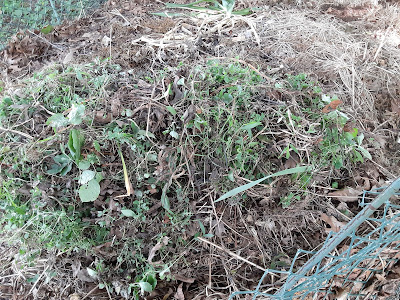I, however, am a gardener. With a three-day holiday weekend all but assuring me of lots of people on the trails I walk to listen for birds, I took one of those days to bring my pail, bench and spade to the ornamental grass garden to get at the weeds that have run rampant thanks to heat, rain and lack of attention from me.

An assortment of weeds including milkweed, wild strawberry,
ground ivy, oxalis and others I can't identify.
(Margo D. Beller)
Weeding is the last thing I want to do on a hot summer morning, but this holiday weekend was blessedly less humid and a tad cooler, allowing me to gird myself for battle. And battle I did.
I can identify many, but far from all, of the weeds I was pulling. There are strawberry vines, a clover-like plant called oxalis, my old nemesis the ground ivy, wild violets, dandelions. There is also lawn grass that has gone feral and moved into the plant area.
On another cool morning I had spent several hours pulling oxalis that had grown so tall it was obscuring the plants in the sunny front plots. This time, however, the oxalis was more spread out, in some areas almost like a vine, somehow growing behind the tall ornamental grasses in much less sun.
Milkweed has shown up in this area, but because it doesn't get much sun it hasn't grown the flowers that benefit monarch butterflies. But the plant spreads through underground runners, so pulling up what is above the ground doesn't stop what is below.
 |
| The sharp blades of ornamental grass. (Margo D. Beller) |
I have to tip my hat to weeds and their methods of survival. Oxalis and the other weeds I was pulling from behind and beneath the ornamental grasses get only a small bit of sun, usually in the early morning and late afternoon, but it is enough for them. With a spade oxalis comes up easily but it is also fragile and will break. You grab a handful, pull it out, then see you left some behind. Even if you get these there may be more under the soil surface.
Some of the weeds I pulled were growing next to stones, which makes the plants hard to get with the spade. They also grow next to plants I don't want to uproot, which means I have to be careful with the spade not to take out a lily of the valley, for instance.
If the weed has a taproot, like the dandelion, I can dig down but rarely pull up the entire root. Usually some is left behind, assuring more to come later. One of the weeds I can't identify could grow into a small tree if left alone, so I try to pull it out or at least take off the foliage to slow the growth.

Ornamental grass (right) and prickly yew (Margo D. Beller)
In this particular plot, there is no netting. That is because I put in plants deer don't tend to browse, in this case three large ornamental grasses that grow after the daffodils are finished and shelter some smaller plants including a bleeding heart. So the weeds grow among the grasses and get wonderful protection. I have to be careful not to get cut by the knife-like blades as I move next to and beneath the grasses.
Also, there is a yew - taxonomy unknown - that sprang up from someplace else, filling a space when several scotch broom shrubs died from the effects of too much snow and too much cold wind one winter. Deer don't eat this yew, unlike the yew hedge nearby, because the leaves of this particular yew are prickly and have a strong scent. I can tell you these leaves scratch as much as the grasses.


No comments:
Post a Comment